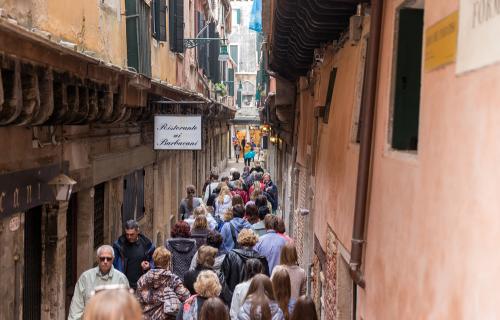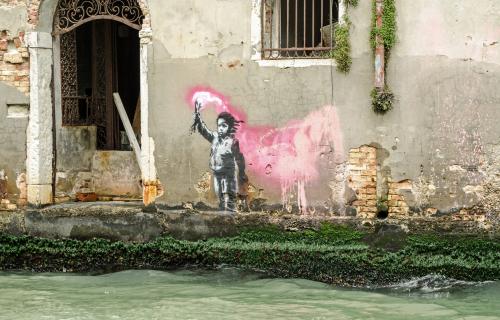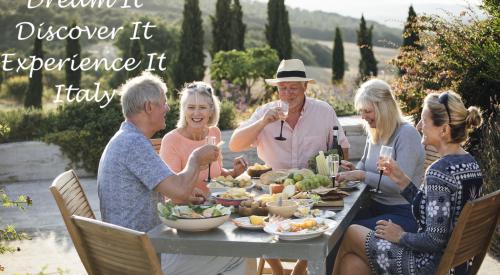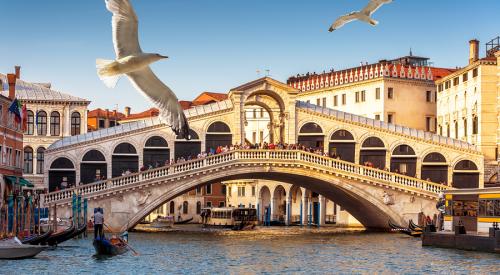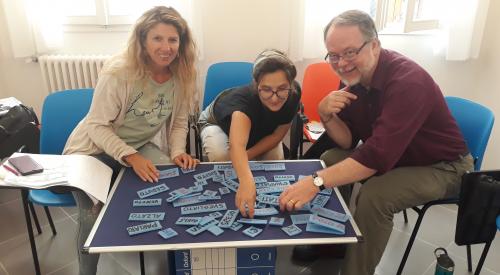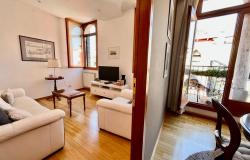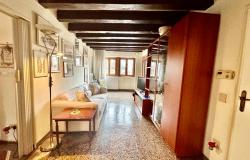How to travel from Marco Polo Airport to the Venice Mestre train terminal?
Venice (Veneto)
Our Essential Guides aim to give you an introductory overview to a region, city or geographical area. For a deeper dive into Venice and the surrounding area in Veneto, check out the Fall 2021 issue of Bellissimo, our quarterly e-magazine for Premium Members.
The Essential Guide to Venice
Venice, located in a lagoon in the Adriatic Sea, in northern Italy’s Veneto region, is built on 117 small islands, separated by canals and connected by bridges. Venice is one of the most important tourist destinations in the world for its celebrated art and architecture, and together with the lagoon, is a UNESCO World Heritage site. The Grand Canal, the major water-traffic corridor in the city, is lined with Renaissance and Gothic palaces. On the central Piazza San Marco, main attractions include St. Mark’s Basilica, tiled with Byzantine mosaics, the Campanile bell tower, offering views of the city’s red roofs, and the Doge's Palace, the former residence of the Doge, the supreme authority of the former Republic of Venice. A gondola ride is a quintessential Venetian experience, just as wandering its maze of calli and campielli.
Planning your trip to Venice: what you need to know
Best times to visit Venice
The most pleasant months to visit Venice are April, May, June, September, and October. However, these are generally also the busiest. Keep in mind that Venice gets approximately 20 million tourists a year; many are day trippers, disembarking from cruise ships. Venice is at its most quiet in the winter months, except during the holidays (especially the days around New Year’s Eve) and Carnival, which is usually in February. Winter however is when the city is cold and humid, and there may be occasional acqua alta, or flooding (but don’t worry, you can easily find rain boots at tobacco shops) and elevated walkways are set up on the busiest squares. In the off-season, prices are lower and lines shorter; sights may close earlier. Temperatures in summer are hot, but not as scorching as in inland cities.
Traveling to Venice
Venice airport (VCE), called Marco Polo to honor the memory of the Venetian explorer, is located on the mainland approximately six kilometers north of Venice and served by more than 40 airlines. It offers direct flights to and from the East Coast of the United States.
The airport is connected to the nearby railway station of Venice Mestre on the mainland, which provides connection to the rest of Italy; to the bus terminal of Piazzale Roma at the entrance to Venice by scheduled bus services; to several destinations in Venice itself by the Alilaguna water shuttle; and to Piazza San Marco by the express Gold Line or water taxi.
Another airport located in the Venice area, Treviso Airport, sometimes labeled as Venice – Treviso mostly serves low-cost airlines, such as RyanAir.
Venice’s train station is Santa Lucia and is served by hundreds of trains every day, including Frecciarossa and Italo high-speed trains. The station sits across the lagoon, right on the Grand Canal, in Venice's Cannaregio district. The Ponte dei Scalzi bridge, close to the station's entrance, crosses the Grand Canal to the Santa Croce district; it’s 20 to 30 minutes to reach Saint Mark’s Square. The Ponte della Costituzione connects the station with the Piazzale Roma parking lot and cruise terminal. There is also a vaporetto (water bus) stop right in front of the station.
*Check our ultimate guide to train travel in Italy.
How to get around in Venice
The historic center of Venice is not accessible to motor vehicles, so you get around in Venice by walking. And that’s the beauty of it, getting lost in its maze of calli, campielli, sotoportegos (passageways underneath a building), bridges large and small. Venture beyond the most touristed areas to discover quiet sestieri (neighborhoods) where Venetians go about their daily lives.
There are vaporettos, or water buses, which connect the main points of interest and the islands of the lagoon. At €7.50 for a single ticket, they don’t come cheap. The city center lines sail along the Grand Canal.
Water taxis take you to your destination quickly but they are the most expensive transportation option; however, they can carry up to ten people so if you’re in a group it may be worth it to, say, quickly reach your hotel.
Then of course there is the gondola, not so much a way to get around, but rather a quintessential Venetian experience. Routes and prices, but you may expect to pay around €80 for a private 30-minute tour.
What to see in Venice
St. Mark’s Square & Basilica - Saint Mark’s Square is the former political and religious center of the Republic of Venice, and today it is still considered the heart of the lagoon city. On it stands the magnificent St. Mark’s Basilica whose interiors are covered with splendid mosaics depicting saints, prophets, and biblical scenes.
St. Mark’s Campanile - The bell tower of Saint Mark’s Basilica is one of the most recognizable symbols of Venice, and, at 98.6 meters (323 ft) in height, it is the tallest structure in Venice. Ascend to the top for a glorious view of the city and the lagoon.
Doge’s Palace - As the name suggests, this was the residence of the Doge, the supreme authority of the former Republic of Venice. It was built in 1340; highlights of the visit include the Doge’s Apartments; the institutional halls with their beautiful decorations; the old prison spaces of Piombi; and the famous Bridge of Sighs, built in 1614 to link the Doge's Palace to the structure intended to house the New Prisons.
Rialto Bridge - An architectural icon of Venice, the Rialto bridge is the oldest (and most famous) of the four bridges spanning the Grand Canal, connecting the San Marco district with San Polo.
Gallerie dell’Accademia Museum - The Gallerie dell’Accademia house the greatest collection of Venetian painting in the world, with masterpieces by Giorgione, Bellini, Titian, Veronese and Tintoretto among others.
Basilica di Santa Maria Gloriosa dei Frari - Usually just called the Frari, this is the largest church in Venice, located in the Campo dei Frari at the heart of the San Polo district. It is one of the city's three notable churches still retaining their Venetian Gothic style.
Scuola Grande di San Rocco - Some of Tintoretto’s finest work is housed in the Scuola Grande di San Rocco, less than ten minutes from the train station, which some describe as ‘the Sistine Chapel of Venice,’ for the number of characters, colors, figures, shapes and stories from the Old and New Testament. Art lovers should not miss this!
Ca’ Rezzonico - Ca’ Rezzonico is a palazzo on the Grand Canal in the Dorsoduro district. It is a notable example of the 18th-century Venetian Baroque and Rococo architecture and interior decoration, and displays paintings by the leading Venetian painters of the period.
The Peggy Guggenheim Collection - The popular Peggy Guggenheim Collection is one of the world’s most important museums of European and American art of the 20th century. Located in Dorsoduro, it is housed in the Palazzo Venier dei Leoni, which was the home of the American heiress Peggy Guggenheim for three decades.
Murano - This island of the Venetian lagoon is famous for its centuries-old tradition of glass-making. In Murano, you can still see artisans perform this delicate technique, which shapes glass with fire using a blowtorch, creating a variety of colorful objects, from vases to glasses to candlesticks and jewelry.
Burano - An island at the northern end of the lagoon, Burano is known for its lace work and brightly colored houses.
What to eat in Venice
The cuisine of Venice combines local traditions with influences stemming from centuries-old contacts with distant countries, as the city was once the capital of a large trading empire.
Many of Venice’s traditional dishes are fish-based. Other typical dishes include risotto, polenta and cicchetti.
The most popular Venetian dishes include: sarde in saor, sardines marinated to preserve them for long voyages; baccalà mantecato, stockfish cooked in milk and then pounded with olive oil, eaten with white or yellow polenta; risi e bisi, a type of risotto made from peas and pancetta; fegato alla veneziana, Venetian-style veal liver; risòto col néro de sépe, risotto with cuttlefish, blackened by their own ink; cichéti, small plates served as aperitivo in bacari, the city’s traditional wine bars, often accompanied by the ubiquitous Prosecco.
Where to stay in Venice: neighborhood guide
Venice is divided into six sestieri, three on each bank of the Canal Grande. This subdivision dates back to Venice’s origins.
Castello – overlooking the sea, Castello is the most easterly sestiere. Its name derives from the fortress that once stood in the area as a defense post, around which the neighborhood grew. Castello is where the Arsenale, a complex of former shipyards and armories, once the heart of Venice’s thriving naval industry, is located.
San Marco – the political and religious heart of the city since Venice’s foundation, it takes its name from the Basilica of the same name. It is the original nucleus of the city. San Marco is bordered to the north by Cannaregio and to the east by Castello; it connects to San Polo via the Rialto Bridge and to Dorsoduro via Accademia Bridge.
Cannaregio – this is the area closer to the mainland. Cannaregio is the second largest of the sestieri after Castello, and the most populous. It occupies almost entirely the part of the city to the north of the Canal Grande.
San Polo – the smallest of the sestieri, concentrated in a bend of the Grand Canal, it is connected to San Marco though the famous Rialto Bridge. It takes its name from the Church of San Polo and is at the center of Venice. It is home to the popular Rialto food market, where Venetians go shopping for fresh fish, vegetables, fruit and more.
Santa Croce – it takes its name from the church and monastery of the same name, which were demolished in the 19th century. It has undergone several changes in the 20th century, becoming the car and bus hub of the lagoon city; this is where Piazzale Roma, home to Venice's bus station and car parks, Tronchetto, a car park for tourists, and the main port are located.
Dorsoduro – this is the southern area of the city and takes its name from the compact sand dunes that made the ground harder (dorso duro = hard back) and less swampy than in other parts of Venice; in the past, the wood that came from the Cadore forests and was used to build boats, was unloaded on its massive sand pier.
Venice Highlights
What you can't miss in Venice
Where is Venice

Top Experiences in Venice
Properties for sale in Venice
Recipes From Veneto
What others are saying about Venice
I am going to Venice for a week from 7th November staying in a Home Exchange near Rialto - to live like Venetian.





